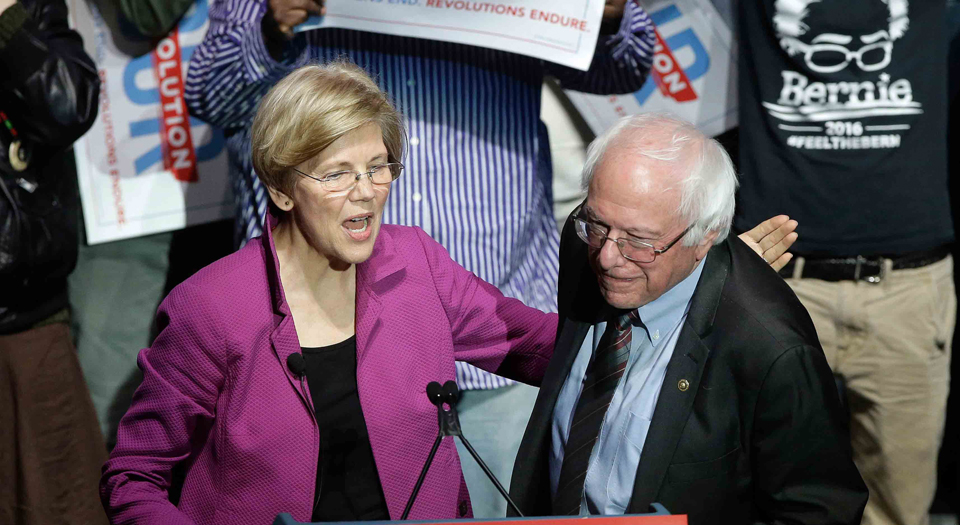
A lot of energy has gone into railing against the tax policy proposals forwarded by Elizabeth Warren and Bernie Sanders. In the most general terms, they both push hard for raising taxes on the extremely wealthy, the wealthiest of the wealthiest, who have been able to avail themselves of the opportunities this nation affords to accumulate vast fortunes.
If you stop to think about it, the vociferous opposition to these proposals, cast in fear-mongering hysteria that they represent the imposition of European socialism on America, is rather disproportionate in relation to the modesty of what they actually would entail for less than the top .1% of households if actually implemented.
Yes, you heard that right — the top .1%. All of this fervor, this Sturm und Drang, stirred up by these proposals is about protecting the excessive wealth of 75,000 households in America.
Meanwhile, much less, even very little, attention and energy are devoted to understanding the benefits of this tax for the majority of Americans in terms of enabling them to take care of our nation’s children, to pursue higher education, and thus to contribute to the economy.
If the tax proposals have generated this much hostility, inspiring such concern for less than .1% of households, we must wonder why. Most of us don’t belong to this elite minority group, so what is at stake in this defense? Is it some sacred standard of fairness?
Emmanuel Saez and Gabriel Zucman see this defense not as rooted in a standard of fairness but rather as exemplifying, to borrow the title of their latest book, the triumph of injustice. In The Triumph of Injustice, Saez and Zucman, both economists who contributed to the crafting of Warren’s wealth tax, chart the collapse of tax rates for the rich to levels not seen since the 1920s. This history of taxation is important, telling an important dimension of the history of class struggle in America.
Readers of People’s World likely understand and explain this dynamic as reflective of the class struggle that, as Karl Marx tells us, has characterized “the history of all hitherto existing society.” The corporate media purveys the ideas and tells the stories that underwrite and ratify the interests of the ruling class, the .1%, representing those interests as if they serve us all.
Unfortunately, the powerful anti-communist elements of U.S. culture and history have succeeded in making Marx’s historical and social analysis largely inaccessible to many Americans, meaning the vocabulary of class struggle does not animate their talking points or even the way they comprehend the world, minimizing counter-weights to the corporate media.
The tax policies of Sanders and Warren, however, do present the opportunity for those on the left to develop an effective language and set of numbers to comprehend dynamics of class struggle and the depth of income and class inequality that thus distributes social and political power unequally.
Developing a language of class struggle and analysis
Let’s unpack Sanders’s and Warren’s proposals to think about ways to challenge the narrative that their proposals are somehow outrageously unfair, counter to American values, and threatening to the economic health of the nation.
And as we do so, let’s keep in mind that the top marginal tax rate for individuals in the U.S. through the 1950s and 1960s exceeded 90%; from 1971 through 1980, the top rate was 70%; and Ronald Reagan cut the top rate to 50% in 1982. In recent years, the top rate has fluctuated between the mid- to high-30s.
So, in a decade of decided prosperity, the 1950s, the nation’s cultural ethos upheld as fair a top marginal tax rate of 90%.
This history is important to note to challenge the absurd notion that the policy proposals of Warren and Sanders represent the onslaught of European socialism in America
What do Warren and Sanders propose?
Warren proposes a 2% tax on wealth over $50 million and 3% on wealth over $1 billion. Sanders would tax those worth $32 million at 1% — meaning his tax would hit about 180,000 families versus about 75,000 households under Warren’s proposal.
Sanders’s plan also escalates the tax rate for wealth over $500 million, which would be taxed at 4%. Wealth over $10 billion would be taxed at a rate of 8%.
In terms of our own nation’s history of taxation, it seems hard to cry foul and question fairness.
Even in the context of U.S. capitalism’s history, these tax plans tilt to the side of modesty.
Outlining this history and where Sanders’s and Warren’s proposals fit in relation to that history will hopefully shift Americans to think about tax policy as a key site of class struggle where there is some possibility of working for wealth redistribution in America.
Class struggle by the numbers
We might inspire people to ponder if there is a standard beyond fairness we might just call decency.
Getting people to understand the magnitude of income inequality seems important in this regard, especially because the magnitude is so unimaginable.
At some point, we need to ask those who protest these proposals, “How much is enough?” How much do they need? When will both we and they decide that they now have enough wealth that they give some up to make the lives of those living in the nation that helped them make that wealth livable in the most basic of ways?
Robert Frank reports for CNBC that under Sanders’s plan, Jeff Bezos would pay $9 billion in taxes. The deadline screams with outrage. And we get the list: Bill Gates would pay $8.6 billion, Warren Buffet $6.6 billion, Mark Zuckerberg $5.8 billion, and so on.
Surely, these are large tax bills. To put it in perspective, if one earned the comfortable salary of $100,000 annually, it would take 9,000 years just to earn enough to pay Bezos’s bill.
But then think about tens of billions in income these people enjoy. Are they suffering? Mark Zuckerberg, worth $66 billion, could spend $1,200.00 per minute for a century and still be wealthy.
Jeff Bezos, who just canceled health insurance for his part-time workers at Whole Foods, could afford to give each of those 1,900 workers $500,000 and still be worth $113 billion.
That person earning $100,000 annually, makes $3 million working for 30 years. These billionaires make multiples of that in one day.
They won’t be suffering, but many in the U.S. do, struggling to meet basic health and housing needs, afford education, and more. So how much is enough before we decide those with billions can pay a little more? Before they decide?
Here are the benefits of Warren’s plan:
The tax would impact, it is projected, about 75,000 households (less than .1%) and raise $275 trillion over ten years. These revenues would be used to pay for universal childcare and pre-K ($700 billion over ten years); free college tuition at public institutions, money for historically Black colleges, and the forgiving of a good portion of student loan debt (together all of this costs $1.25 trillion over ten years); and then she proposes the remaining $750 billion would be down payments on Medicare-for-all and the green new deal.
And let’s point out that, really, all of these benefits help the wealthy as well. We all need to save the planet; providing childcare helps people participate in the economy; educating them provides workers for businesses.
We often hear from state and national leaders, when it comes to making budgets, that we just don’t have enough to take care of all our needs.
The plans of Warren and Sanders beg the question, “Do we have enough as a nation to meet the needs of our people?” The answer seems to be, emphatically, “Yes.”
So what holds us back from creating a humane economy and society, the Great Society?
We love to believe that people simply don’t deserve to have basic needs met, that they don’t work hard enough or contribute enough — that they simply aren’t deserving.
Maybe one day we’ll ask ourselves if Jeff Bezos really works tens of thousands of times harder than the teacher who helps educates his workers, the custodian who keeps his office clean, the factory workers who make the products he sells.
For now, let’s ask, “How much is enough?” and “Don’t we have enough to go around?”
Asking these questions and underscoring the numbers here and what they reveal about the grossly unequal distribution of wealth and power may take us a long way toward developing a language of class struggle to inspire people to act.












Comments